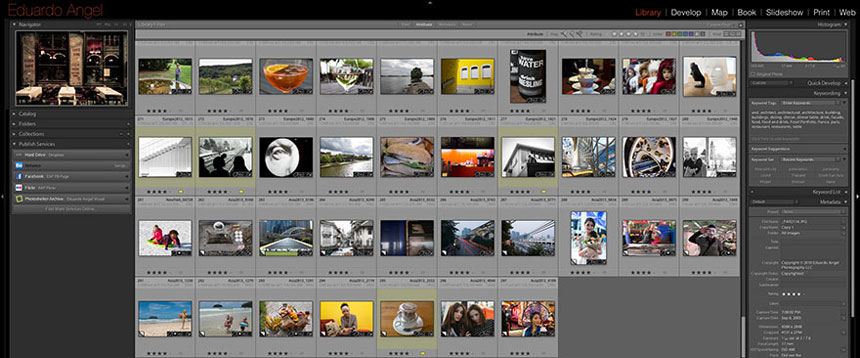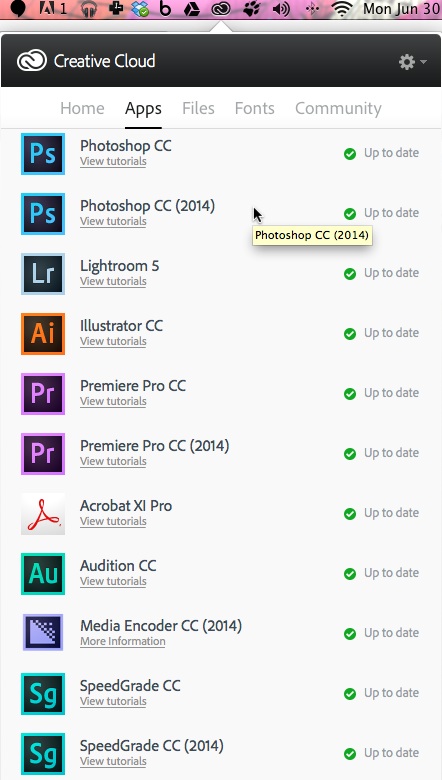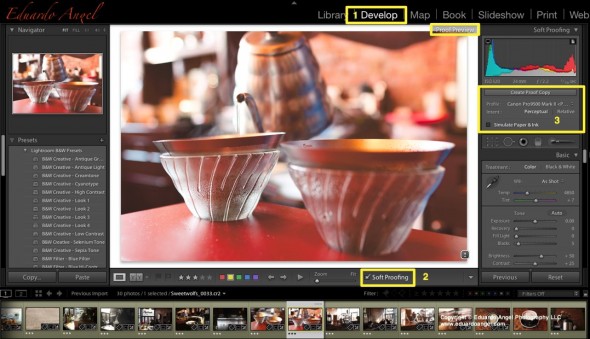Photography

Say Adiós To Aperture.
Apple will cease to develop Aperture and iPhoto when Yosemite drops this Fall.
UPDATED 20140718: A third party software solution to migrate from Aperture to Adobe Lightroom 5 is now available. Fair warning, the software is still in beta so I’d make a backup of all catalogs/libraries before proceeding.
What’s going on?
Apple’s OS X Yosemite is set to be released to the public this fall. One of the update’s big changes: Apple will stop development of Aperture and iPhoto. The writing has been on the wall for a while. Apple hopes current Aperture and iPhoto users will make the transition to Photos, which is a new application that will be launched in 2015.
For some time compatibility updates will continue for Aperture, so current users will be able to use it when running Yosemite, but all new development of the program will cease. In theory, once Photos starts shipping next year, users will be able to migrate their existing Aperture libraries.
According to Apple the introduction of the new Photos app and iCloud Photo Library, will enable users to safely store their images in iCloud and access them from anywhere.
As soon as I saw the announcement, several thoughts crossed my mind:
• Will Photos be as robust as Aperture? My guess is that Photos will be more geared toward hobbyists and prosumers than pro photographers.
• iCloud has never worked well. Not even Apple employees use iCloud internally! Why would someone trust it with his or her most precious memories? There are MUCH better cloud storage offerings available.
• We haven’t seen any major updates or improvements for Aperture or iPhoto in the past several years. Would the company suddenly pay attention to photography?
• Would Apple support RAW images shot with professional cameras or only the ones captured on iPhones?
• Considering Apple’s recent track record, I wonder how long it will be before Photos ends up as neglected as Aperture and iPhoto.
Not a pretty picture.
What now?
The other side of the coin: Adobe Lightroom. This software application has been around since 2007, about 6 months after Aperture was first launched. I have been an avid user and trainer of the program since Version 1; in fact, before its release, and on a few recent versions I have even served as an official Beta Tester for Adobe. I’m not exaggerating in the least when I say that I could not imagine my life as a professional photographer without Lightroom.
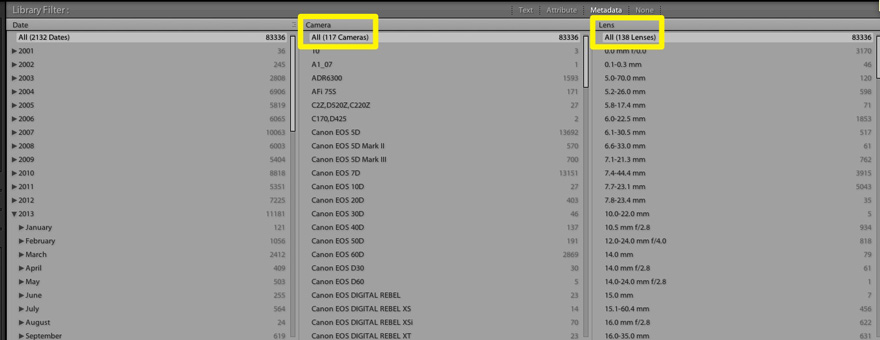
I’m definitively NOT a light user of Lightroom. My stills catalog holds over 100k RAW images from 117 cameras and 138 lenses.
I remember when Aperture seemed to have the best goodies, like book publishing, maps, faster processing, and better camera support. That’s no longer true. Adobe has done a good job listening to users needs (and demands) and has improved the software to what we have today. I have written numerous posts on Lightroom, most recently on “Smart Previews” which I’ve called the current version’s awesomest feature.
While Apple treated Aperture like the proverbial redheaded stepchild, Adobe lavished plenty of attention and resources upon Lightroom in the past seven years. It’s been regularly updated, and a new version is expected to be released this year (more about this on another post).
Over time (and after some criticism and disbelief) I’ve become a big fan of Adobe’s Creative Cloud. We use at least ten different applications almost daily, and constantly receive updates and improvements, all for $21.76 per month (one of the perks of being an educator).
If you don’t need all these applications, Adobe recently made “permanent” the Creative Cloud Photography plan. It includes Photoshop CC AND Lightroom 5 and some perks for only $9.99 per month.
With Aperture entering the twilight of its relevance, there’s no time like the present to consider how this will impact your current and future workflows. If you’ve been contemplating making the transition to Lightroom, we’re here to help.
At the start of 2014 we launched our Google Lightroom Helpouts, which is an online collaboration service that enhances one-on-one live video training. In our Adobe Lightroom Essential Training we offer one-on-one live video training that suit your specific needs, from capture to output.
These one-on-one sessions cover a wide range of topics like how to organize photos and videos so they’re easy to find; enhancing images from good to great, sharing images via email, blog, or social media platforms; transferring photos from Aperture, iPhoto or another app to Lightroom; and backing up your valuable images.
It easy to see why Lightroom has become the preferred image-management and editing software for photographers and artists the world over. Why wait to improve or switch over?
UPDATE: The Photography plan will soon be available on Amazon, perhaps for even less !
Video
Gulf Photo Plus 2013 Workshops in Dubai.
We are truly honored to be a part of the upcoming Gulf Photo Plus (GPP) Workshops in Dubai. From March 1-8 2013, we will be teaming up with industry leading professionals Joe McNally, Gregory Heisler, David Hobby, Zack Arias, Peter Hurley, Bobbi Lane, and other great photo instructors for an unforgettable event. We will have a jam-packed week with workshops and activities aimed to help improve skills, inspire, and educate photographers at every level of expertise. Taking place at the core of the Middle East’s photo community, this is going to be one incredible week!
We are thrilled to present two “Photo Friday” seminars AND two 3-day Workshops introducing the craft of Digital Filmmaking to photographers. As we all know, the emergence of HD Video in current cameras has opened up a new world to photographers and cinematographers, widening the creative palette for visual expression. Our workshop’s emphasis will be on reinforcing the theory behind the technique; understanding the equipment and processes rather than concentrating on a finished product. Here are some of the many topics we will cover, all while working as a small film crew: Digital cinema workflow, new terms and techniques, Adobe Premier Pro, script writing, production considerations, budgeting, and the most essential gear.
Check out below what our workshop is about:
David Hobby, the famous and respected “Strobist” recently said “I happen to think this is the best photo week of its kind on the planet. If you are anywhere near that part of the world, GPP is a no-brainer. But even if you are far away, it’s worth the trip.”
That’s what I call a statement.
Below is an AWESOME shoot-out during last year’s GPP between Hobby, Martin Prihoda and Gregory Heisler. Simply brilliant.
Shoot-Out, GPP 2012 from gulf photo plus on Vimeo.
For a look at what GPP 2013 has to offer, check out their complete list of workshops. This can be the trip of a lifetime.
Photography
Streamlining Adobe Lightroom • NEW Weekly “Tips and Tricks” Series.
The more photos we take, the more photos we need to edit, and the more we need to retouch, back up, search and find. Digital imaging has been great in many ways, like instant review and approval, but it is not making our lives any easier when it comes to time spent in front of the computer.
Photographers need constant access to our photos; we need them to put portfolios and proposals together. After every assignment we need to retouch and deliver the files. Clients will invariably request changes, other versions or different resolutions. When a job is completed, we often need to update our website and blog and start putting new proposals and presentations together.
To make things event more interesting, with recent developments in telecommunications, our clients are expecting that we deliver files right away, and from any location. That is a challenge that we did not have before. All this put together is what I like to call the “constant image cycle”.
Challenge 1
• The more photos we take the more tools we need to manage, organize, and find them.
Challenge 2
• Need to constantly access images to get assignments (proposals, portfolios, presentations, etc.), edit shoots (select best images, retouch, etc.) and deliver final assets.
Challenge 3
• Photographers are expected to deliver images almost instantly and from any location.
All these “challenges” rely on the same non-renewable resource: Time.

I have been a Lightroom user, beta tester, instructor and evangelist since version 1. Actually, I remember beta testing the very first version under the secret code name “Shadowland.” I now use the software almost every day.
After all these years and playing with the app almost every day, I have discovered many great ways to streamline my workflow, mostly by using Lightroom as a database. Starting next week, I’ll be sharing a weekly tip on this blog. Some tips might be familiar to veteran Lightroom users; some approaches might be entirely new. Some will help you to get things done quicker, while others will entirely replace outdated steps. I hope you join me on this project, and as always feel free to ask questions, comment on the tip of the week, and suggest improvements.If you are interested in other topics, please let us know here (and get a chance to win a $100 Amazon Gift Card!).
UPDATE 20130115 Tip & Trick #1, and Tip & Trick #2.
UPDATE 20130214 Tip & Trick #3, and Tip & Trick #4
If you have specific questions or want to learn more, we are now offering virtual one-on-one sessions to give you customized solutions and personalized training no matter where you are in the world. Sign up now!
Video
50% off on Adobe Lightroom 4, today only.
Here’s the deal: the full version of Adobe Lightroom is normally $299. The upgrade price is generally $99. Today only, B&H is offering Lightroom 3 for $69. If you are running an older version, or need additional licenses, you can buy version 3 today, and upgrade to version 4 when it becomes available in early April. You will effectively get the new version for almost half price.
To really understand why this is such an amazing deal, check all the new features on Adobe Lightroom 4. Don’t wait. The deal expires tonight, Feb 15, at 11:59PM EST.
Video
Adobe Lightroom 4 HDSLR video support explained.
UPDATE March 6, 2012. The full version of Lightroom 4 is available now and Adobe cut the price in half: The full version (which used to cost $299) will now be $149. The upgrade version will only cost $79. The beta version (which was downloaded more than 250,000 times) will expire on March 31, 2012.
My birthday was yesterday, and the present arrived this morning. Lightroom 4.0 (public beta) FULL VERSION is now available as a free download from Adobe’s website.
Important things to consider:
• You do not need a serial number and the beta version will not update your current Lightroom 3 (or earlier) catalog.
• The public beta comes in three flavors: Mac (OS X v10.6.8 Snow Leopard) or v10.7 Lion), Windows 32-bit, and Windows 64-bit. Make sure you download the correct version. Each compressed download is about 400MB.
• File support for Lightroom 4 beta, is exactly the same as in Lightroom 3.6 and Camera Raw 6.6.
• The public beta will expire on March 31, 2012, when the final Version 4 becomes available.
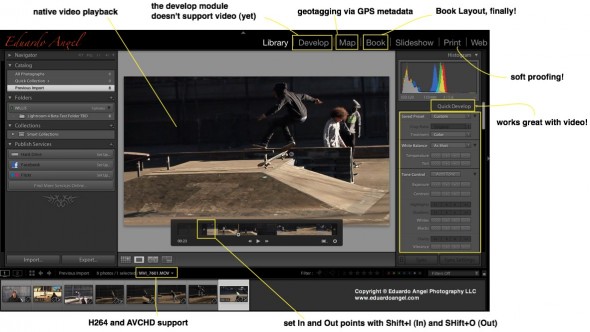
Here are the new features, organized from super awesome to awesome:
• HDSLR video support (full details below)
• Soft proofing (found under the Develop Module, not the Print Module as one would expect)
• Photo book layout
• Email directly from Lightroom (works with Gmail, Yahoo, Hotmail, and AOL)
• Publish videos directly to Facebook or Flickr
• Geo location (via GPS metadata) with the Map Module
• Enhanced DNG workflows
• Adobe Revel (Carousel) export workflow
• Additional local adjustments including Noise Reduction and White Balance
• Powerful new Shadow and Highlight controls
• Simplified basic adjustments
Video
Regarding Video Support this is what Adobe has to say:
“Lightroom 3 added the ability to import, manage and tag video files but as the popularity of video capture increases it’s important to provide a single, robust workflow solution that can support all of your imaging needs regardless if they’re still images or video captures. Lightroom 4 adds native playback for a wide variety of formats from mobile phones to high end DSLRs.”
Here’s what I have to say: In version 3, we were able to import video files along with our still images, but to see the clips Lightroom needed to access Quicktime. Now we can play the files inside of LR. Also, by using similar shortcuts from well established NLE (non linear editing) software applications like Final Cut Pro and Adobe Premiere Pro, now we can set In and Out points directly in Lightroom. Shift+I (In) and Shift+O (Out).

